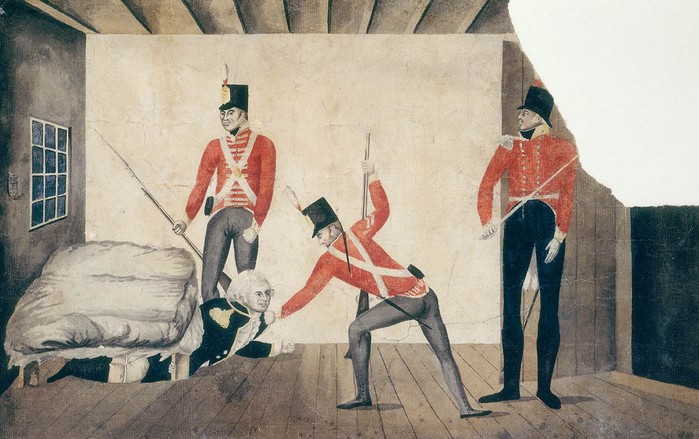The arrest of Governor Bligh
Watercolour
Safe 4 / 5
Presented 1891
This iconic early colonial
watercolour ‘cartoon’ is believed to have been commissioned by Sergeant Thomas
Whittle, a N.S.W. Corps soldier, just hours after the event and displayed in his
home a couple of days after the Governor’s arrest, to show Bligh’s cowardice. The uniformed officer in the centre of the painting is thought
to be Major George Johnston, senior officer of the N.S.W. Corps, who
ordered Bligh's arrest. Attached to the left hand wall is a sheet with the motto, 'O [dear] what can the matter be', from a traditional English nursery
rhyme.
Australian artists have largely ignored our government’s one
and only military coup. Friend’s rendition is simultaneously arresting, tense
and comic – qualities not common to Australian painting before Pop art or the
post-modernist movement.
Governor Bligh remained in confinement at
Government House for a year, as he refused to sail back to England until he
received lawful orders to return.
On the day of the coup, John MacArthur had
drafted a petition appealing to the military to arrest Governor Bligh as a
tyrant. The 150 or so signatures appearing on the surviving manuscript of that
petition are now known to have been added after the event.
Friend’s blazing irreverence and cutting wit fuelled the bold
strokes and radical innovation displayed in this series of gilded history panel
paintings which also included Joseph Banks at Botany Bay (n.d), Murray River
Explorer’s (1962) and a pair of ‘Ned Kelly’ scenes (ca. 1965) among many
others.
The NSW Corps marched up Bridge Street from
the military barracks in High Street (now George Street) with colour flying and
playing ‘The British Grenadiers’ on fife and drum.
Governor Bligh’s recently widowed daughter,
Mrs Mary Putland, accompanied her father to NSW to act as his hostess. She met
the NSW Corps at the gates of Government House where she attempted,
unsuccessfully, to bar the soldiers from entering the property.
The framed ship picture, hanging on the wall next to the
door, is labelled ‘The Bounty’ in reference to Bligh’s famous command.
The pink dog, in the foreground on the left, is portrayed
barking inaudibly with visibly wagging tail which seems to add to the noise and
confusion of the scene.



 Back to list
Back to list